Split-Dalmatia County IT Entrepreneurship Encouraged with Cash Sums
January the 10th, 2023 - A generous non-refundable cash sum has been provided to boost Split-Dalmatia County IT entrepreneurship. Hefty individual amounts of that cash will be being awarded in the form of grants to encourage such entrepreneurship in the country's largest county.
As Poslovni Dnevnik writes, despite not remotely encompassing the capital city of Zagreb, Split-Dalmatia County is the largest county in all of Croatia, and it is set to award handsome grants to encourage Split-Dalmatia County IT entrepreneurship in the wider area. As a boost to those who work in this blossoming field, fifteen prizes in the amount of 50,000 kuna to 200,000 kuna (over 6,500 euros and over 26,500 euros respectively) will be awarded to the best projects.
The highest amount, 200,000 kuna, will be awarded for the first prize, 100,000 kuna for the second, 90,000 kuna for the third, and 50,000 kuna for the remaining twelve prizes, which comes to a total of 990,000 kuna.
The applicants must be business entities which are currently in the process of developing an IT product or service with their headquarters registered somewhere within the scope of Split-Dalmatia County, and they must have been registered for a maximum of sixty months.
The applicants must be registered as trades, simple limited liability companies (j.d.o.o.) or limited liability companies (d.o.o.), i.e. small business entities established by the law which establishes the encouragement of small business development that are entirely privately owned, operate and have a registered headquarters in Split-Dalmatia County.
The county will award grants based on a public tender that will remain open until the end of January 2023. More detailed information on these Split-Dalmatia County IT entreprenership grants is available on the county's official website.
For more on Croatian companies, innovation and entrepreneurs, make sure to check out our dedicated business section.
Eco-village Vrsine and Inland Marina: Holidays in All-Natural Dalmatia
December 7, 2021 – How one small community preserves the authentic sights, scents, sounds and flavours of traditional Dalmatia by offering sustainable, all-natural holidays in the hinterland. Meet Eco-village Vrsine and inland Marina.
Everything best about a holiday in Dalmatia is a gift of nature. Whether it's the sunshine-filled days, the crystal clear seas, the fresh food on your plate or the scent of lavender, pines and herbs. These are the memories of Dalmatia that last. Timeless, inimitable, unique.
And yet, in our rush to experience Dalmatia, often we risk losing sight of these fundamental reasons for being here. Holidays in this part of Croatia are often sold by the sleek design of modern apartments, fully air-conditioned hotels and luxury villas. Here, you can choose from 50 different breakfast options and food from all around the world.
But, for those yearning to experience traditional, authentic Dalmatia, the solution is often very simple – step into the hinterland. There, you'll quite often find Dalmatia as it always was, and as it should be.
 Eco-village Vrsine and inland Marina © Ivo Pervan
Eco-village Vrsine and inland Marina © Ivo Pervan
That's certainly the case in the small Dalmatian municipality of Marina. Lying less than 10km to the west of Trogir, less than 40km from Split, Marina is not without a classic Dalmatian coastline. In fact, it has a generous stretch of great beaches around Poljica Bay. But, that's just a tiny taste of what's on offer here.
Just a short distance north, up into low lying hills, are villages that hold the true sights, sounds, flavours and scents of Dalmatia. It is a natural landscape, marked by telltale signs of agriculture – rows of vines or olive trees, dry stone walls. Of course, in these times, not everyone here still works in farming. But, many do. And, those who don't still live in harmony with this environment. They might not plough the fields or grow their own food, but everyone in Eco-village Vrsine and many in inland Marina live at one with nature. And, that's how they market themselves as a destination. This is what's on offer just a few minutes back from the sea.
Eco-village Vrsine and Inland Marina
 Eco-village Vrsine and inland Marina © Ivo Pervan
Eco-village Vrsine and inland Marina © Ivo Pervan
Learn the A to Z of Mediterranean olive oil at OPG Šalov (Šalov Family Farm)
 Eco-village Vrsine and inland Marina: OPG Šalov
Eco-village Vrsine and inland Marina: OPG Šalov
The abundance of sunlight and gently rolling slopes make this part of the Dalmatian hinterland perfect for olive groves. Three generations of the Šalov family live and work on the Šalov family farm, looking after their 650 olive trees. Some of them are over 200 years old and the family has deliberately diversified to include 50 different varieties of olives from across the Mediterranean.

This is the opposite of intensive farming, a sustainable endeavour that much reduces the farm's footprint on the environment.

You can visit the farm to learn about olive trees and how the family make their award-winning olive oil. Of course, you get to try the finished product and in October and November, you can even help out with the olive picking – it's all done by hand.
You can learn more about OPG Šalov here
See superfoods in miniature at Jakus Family Farm
 Eco-village Vrsine and inland Marina: Jakus Family Farm
Eco-village Vrsine and inland Marina: Jakus Family Farm
Usually, you don't see very much of the produce from Vesna Jakus's family farm. Well, the microgreens, herbs and edible flowers she grows are very small. And also, they're in high demand.

You'll see leaves and flowers from Jakus Family Farm on plates at some of the fanciest hotels and finest restaurants in Dalmatia. They're full of antioxidants, vitamins, minerals and flavour, making them a chef's favourite.

Vesna grows everything using only organic and GMO-free seeds and all-natural methods. She doesn't use energy-burning lamps. Instead, her greenhouse harnesses sunlight, retaining the heat of the day so the microgreens stay warm at night – even in winter. Some of the varieties she grows are green pea, red beets, mangold, red radish, beans, adzuki beans, sunflower and basil, all of them fed by the rainwater she collects.
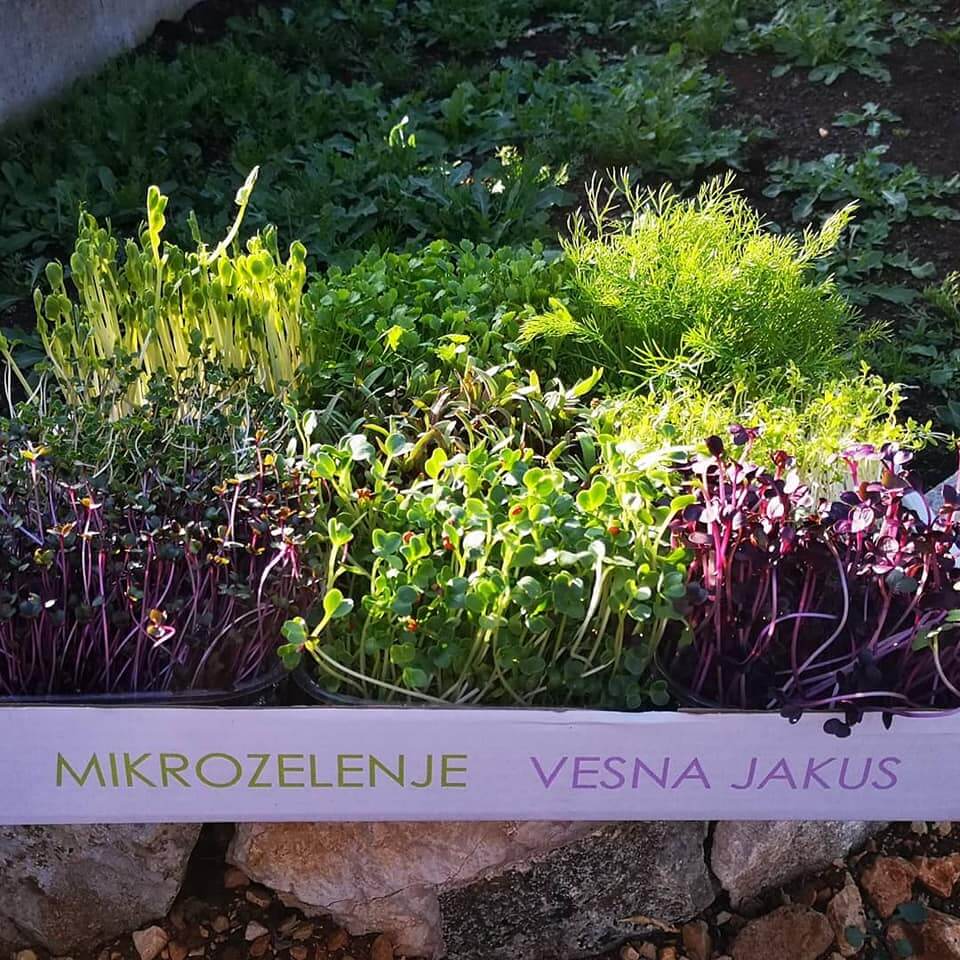
You can learn more about these natural growing methods by visiting Jakus Family Farm and you can see more of what Vesna does here.
Reconnect with You at a holistic wellness and Yoga retreat
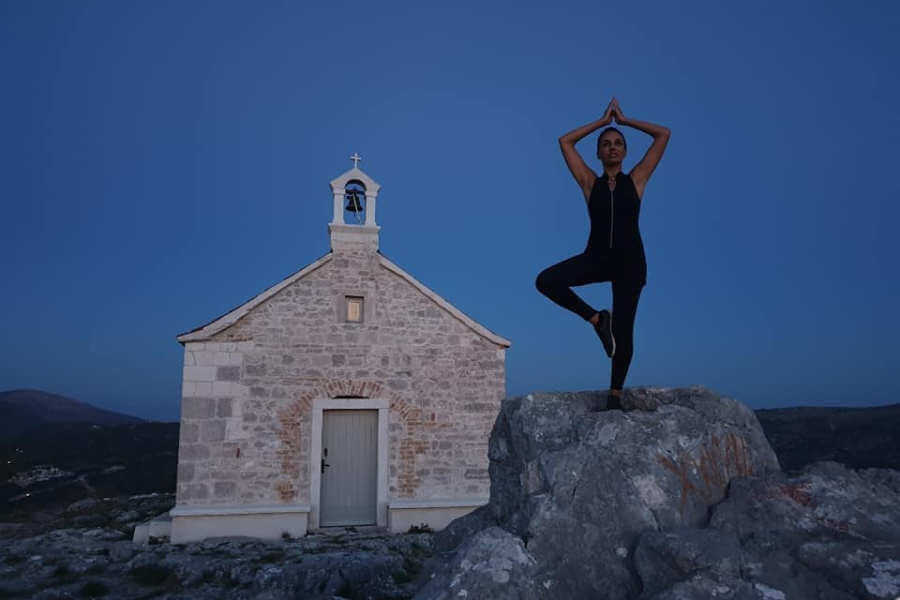 Eco-village Vrsine and inland Marina: Holistic Wellness and Yoga
Eco-village Vrsine and inland Marina: Holistic Wellness and Yoga
Brazilian Yoga and wellness instructor Sylvia Nunes left behind a high flying city career in order to move to Vrsine, where she lives with her partner Mario. But, before the move, a lot of thought went into the relocation and the repurposing of her life.

First, she visited ecovillages around the world and learned how they combined community, sustainability and wellness. The result is the holistic wellness programme that visitors can experience when staying in Eco-village Vrsine with Sylvia.
Held during the spring and autumn seasons, guests at Sylvia's retreats will experience many aspects of the life of the village. They'll connect with the community and the nature that sustains its members. Visitors might take part in tree planting/reforestation programmes and other ecological projects locally. Before every day's endeavours, there are guided yoga sessions held in the peace and calm of the village's nature.
Discover the scents, flavours and wellness properties of Dalmatia's traditional herbs at Rozga Family Herb Farm
 Blizna Gornja in inland Marina: Rozga Family Herb Farm
Blizna Gornja in inland Marina: Rozga Family Herb Farm
If your Dalmatia stay keeps you in restaurants on the coast, you might not encounter many of Dalmatia's herbs. Maybe some rosemary or parsley on your plate, or the scent of lavender from nearby? But, if you travel further back from the shore, up into the foothills around the village of Blizna Gornja, many secrets will be revealed.

Here, herbalist Mira Rozga keeps ancient and localised wisdom alive. Her herb garden sits on the slopes of hinterland hills and in it grow many different kinds of Mediterranean herbs. These are put to use not only as flavourings in food but also in cosmetics and in health, medicine and wellness products.

You can get to know the scents of Dalmatian herbs by walking around the 30 different varieties grown in the Rozga family herb garden. And, you can learn their secret properties from Mira herself. For more information, look here.
Treat yourself to a luxurious but traditional rural stay at Eco Villa Home Sweet Home
 Eco-village Vrsine and inland Marina: Eco Villa Home Sweet Home
Eco-village Vrsine and inland Marina: Eco Villa Home Sweet Home
If you want to take your time in enjoying Eco Village Vrsine and the surrounding villages, a longer stay is advised. And there are few more luxurious choices for doing so than in this traditional stone house, renovated with the specific ethos of the eco-village in mind.

Eco Villa Home Sweet Home preserves the original architecture of a centuries-old Dalmatian stone house. But, it enhances its fit into today's environment by using modern innovation. Power comes from strips of solar panelling atop the roof, there's an extensive organic garden, furnishings made by local artisans, enough WiFi to work remotely and a pool.
The villa is available to rent year-round and you can find out more here.
Immerse yourself in nature on a camping stay at Robinson Glamping Camp Marta
 Eco-village Vrsine and inland Marina: Robinson Glamping Camp Marta
Eco-village Vrsine and inland Marina: Robinson Glamping Camp Marta
Holiday accommodation often feels far removed from traditional and the natural environment. At Robinson Glamping Camp Marta it's the opposite.

You'll fall asleep every night surrounded by the scent of lavender and herbs. When you wake in the morning, your first sight is the olive grove in which your glamping hut is placed.

The huts themselves are made from all-natural materials – the huts are made of wood, then sheltered from the sun by a canvas tent. The whole 12,500 m2 plot is surrounded by traditional drystone walls and there's a covered picnic area and generous pool too.
Find out more here.
Taste the full and delicious flavours of traditional Dalmatian food at Konoba Donja Banda
 Eco-village Vrsine and inland Marina: Konoba Donja Banda
Eco-village Vrsine and inland Marina: Konoba Donja Banda
One of the greatest secrets to learn of a holiday in Dalmatia – but rarely one of the first – is that quite often, the further from the shore you travel, the better the food will be.
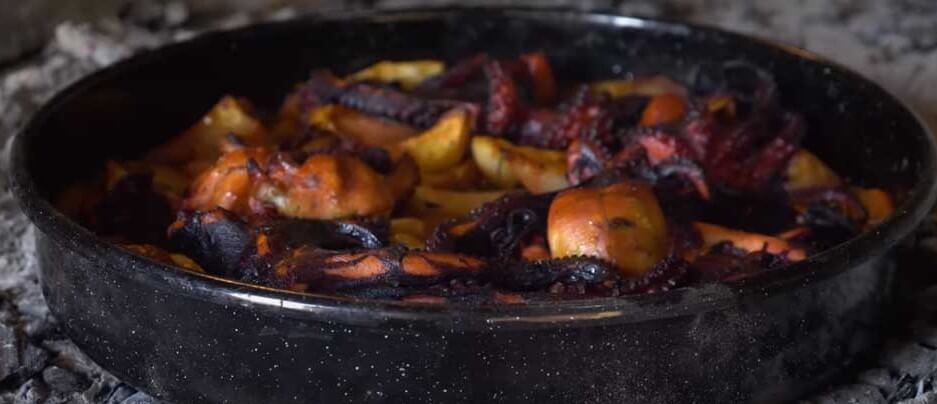 Peka at Konoba Donja Banda
Peka at Konoba Donja Banda
You'll find the flavour, range, portion size, authenticity, cost, and quality of ingredients and cooking all improve greatly when you venture inland. Whether that's a trip up into nearby foothills or a trek to a village, town or city restaurant of the true Dalmatian hinterland, you'll discover evidence of this time after time. Taverns have to work that much harder for a reputation when the sea view doesn't sell the meal.
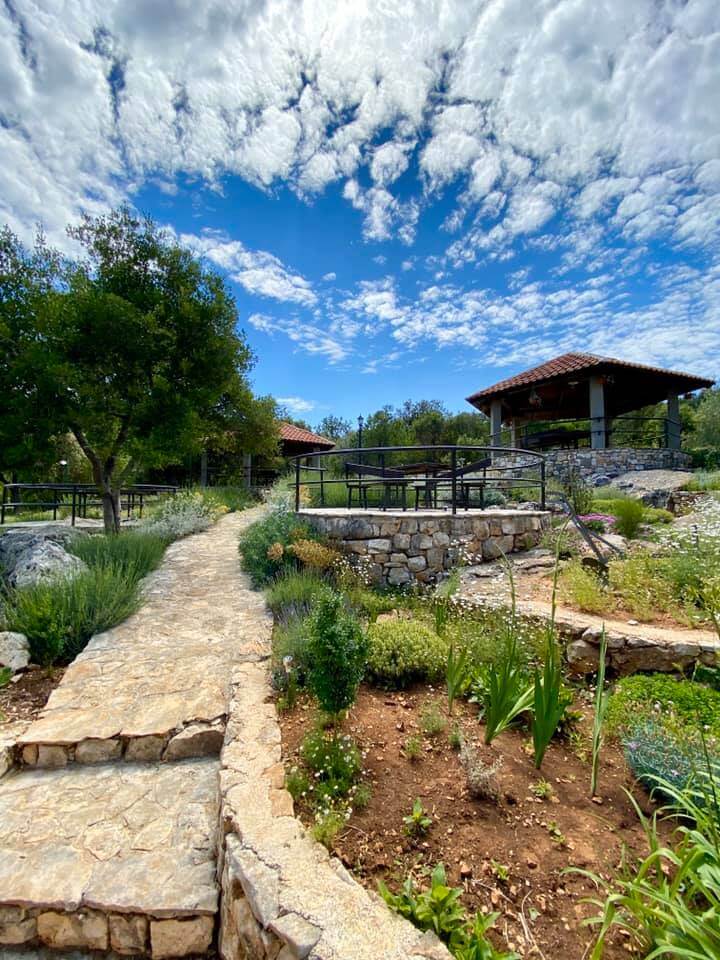
Nowhere is that more true than Tavern Donja Banda, where Roberto Nedeljko maintains the traditional cuisine Vrsine and its surroundings. All of their ingredients are sourced locally, including the olive oil and all of the wines. Indeed, many of their vegetables and herbs come from their own organic garden. Want to try traditional Dalmatian 'peka' – food cooked under a hot metal 'bell'? This is one of the best places in the area.

You can learn more about the tavern here.
You can find out more about holidays in Eco-village Vrsine and inland Marina by visiting Marina tourist board website here. For more great Croatia holiday ideas, bookmark Total Croatia News travel pages here.
Small Renters in Split Especially Hit by COVID-19, Turning to Long-Term Tenants and Students Instead
January 10, 2021 - Small renters in Split are especially struggling from the effects of COVID-19, and many are deregistering their accommodations as tourist facilities.
It's no surprise that 2020 was uneventful when it comes to the number of tourists, resulting in an increased number of deregistered private accommodations, reports Slobodna Dalmacija.
Namely, many private accommodation owners have recorded fewer or no guests due to the coronavirus pandemic. Some are deregistering as tourist accommodation, while others are trying to get tenants for a limited period of stay in the facility, no later than June 1.
"In 2020, in the area of Split-Dalmatia County, 3266 citizens requested to cancel the provision of catering services in the household," says Stjepanka Marčić, head of the Department of Tourism in Split-Dalmatia County, which currently has 26,523 active landlords. Their total number decreased by 11 percent compared to the period before the pandemic.
The highest number of deregistrations was recorded in Split, where 1,200 landlords requested deregistration, i.e., 15 percent of the total number of registered. The least are on the islands of Hvar and Vis, five percent of them," said Stjepanka Marčić.
Citizens submitted requests to deregister throughout the year, most intensively during December 2020.
The most common reason for deregistering is that in 2020, they did not have a single guest, while at the same time, they had to pay taxes, tourist tax, and tourist membership fees. Many decided that it is not worth bearing the cost with no income.
This is confirmed by one landlord, who decided to deregister his apartment in the wider center of Split last fall.
"I paid half the sojourn tax, half was waived. And a membership fee to the Tourist Board, and two lump sum installments, and not a single guest. Not a guest, not even an inquiry. If I hadn't deregistered the apartment in October, I would have paid the last installment of the lump sum. It doesn't make sense," said the Split landlord. At the moment, he is not even thinking about whether to reactivate his apartment for tourist purposes.
"Who knows what will happen in a month? Who can be smart here? They will say that a new strain of corona has come again, and everything will close everything again. Vaccines and masks, and who has been vaccinated twice or thrice.
Of course, in June everything will reopen due to the tourist season and nothing will matter anymore nor will they control who enters the country. And then the locals will shut us down again in October," he added.
The Split-Dalmatia County Tourism Department is reluctant to predict whether and to what extent they will see renters return.
"Citizens who have deregistered will follow the development of the market situation and, accordingly, will decide how to proceed. Some real estate owners in the city of Split have already decided on long-term rentals or renting to students, while others, depending on the situation in the countries of major markets, the interest of foreign and domestic guests, epidemiological rules, flight schedule and calming the pandemic, will consider reactivating their capacities," says Stjepanka Marčić.
Anyone who has deregistered their private accommodation from the Register of Landlords will have to submit a new request, accompanied by the legally prescribed evidence if they change their minds and want to re-host tourists. In the conducted procedure, an inspection will be carried out and a new decision will be made to provide catering services in the household.
By amending the Law on Catering Activity, the deadline for obtaining a permanent solution instead of a temporary one has been extended by one year. Renters who have a temporary solution with a deadline of 31 December 2020 may continue to provide services until 31 December 2021 on the basis of that solution and have no obligation to obtain a new one.
The same deadline applies to caterers who have obtained an interim decision on determining the minimum conditions or an interim decision on the categorization of catering facilities with a deadline of 31 December 2020. They can continue to perform catering activities until 31 December 2021 without obtaining a new decision.
Last year's weak tourist season forced many Dubrovnik renters to turn to long-term rentals, too.
Due to new tax solutions passed in the record 2019, according to which the maximum city taxes per tourist bed and also the maximum high tourist tax for 2021 in Dubrovnik were calculated, many renters canceled the categorization of their apartments.
According to the data of the State Administration Office of the Department of Tourism, as of December 15, 8,397 landlords were registered in Dubrovnik-Neretva County, while last year there were 8,725.
By mid-December, there were 328 fewer private renters or 2,071 fewer beds than last year. Of that, there is a reduction of 141 landlords or 843 beds in the city of Dubrovnik.
Last year, private accommodation in Zadar was 7.34 percent full. This data best illustrates how much the epidemic had an impact on the occupancy of private apartments.
Although the Zadar Tourist Board registered 31 percent occupancy in July and 38 percent in August, it could not save the season. This also had an impact on the interest of renters, whose number is declining.
According to the current data in the eVisitor system, compared to the same period last year, there is four percent less capacity in basic beds and seven percent fewer renters in Zadar.
However, the city's Tourist Board points out that canceling the decision on temporary approval for the provision of catering services in the household is carried out by the Administrative Department for entrusted affairs of the Zadar County State Administration, so the exact number of deregistered capacities will be known in January.
Finally, the number of deregistered accommodations in Šibenik-Knin County in 2020 is 9 percent, and in the city of Šibenik, it has risen to as much as 14 percent, which puts it alongside Split.
"Before the pandemic, there were 8670 landlords in the county, and today there are 7889 of them," said the authorities in the Šibenik-Knin County Department of Tourism. Most deregistered accommodations were recorded in the city of Šibenik, suburbs, and towns, especially in September.
"The most common explanations were uncertainty due to the situation caused by the COVID-19 pandemic. The problem is the payment of obligations, and the landlords do not have announcements of reservations and guests," said Šibenik-Knin County.
A large number of renters who have deregisterd accommodation have announced that they will report them again when the pandemic calms down.
To read more about lifestyle in Croatia, follow TCN's dedicated page.
PHOTOS: Extraordinary Plants of Klis Fortress Show Two Sides of Dalmatia
January 2, 2021 – High on the mountains, overlooking the city of Split, the historic settlement of Klis stands on the border between two distinct climate regions – the Mediterranean and the Dalmatian hinterland. The sometimes rare and extraordinary plants of Klis Fortress are characteristic of both. A new book details the flora you can find on both sides of the Dinaric Alps
The views from Klis are spectacular. The great city of Split lies below you, perched on the edge of the glistening Adriatic, beyond it, the islands of Čiovo, Šolta, Brac, Vis and Hvar. It's a view that has been admired for over 2000 years. The view from Klis Fortress
The view from Klis Fortress
That's how long a fortress has stood here. Restructured and rebuilt several times over the millennia, within the walls of the impressive Klis Fortress lie much of the recent history of these lands – of the Illyrians and the Romans, the arrival of both Slavic people and of Christianity, the defence of Christian Europe from the Ottomans. So steeped in history are these walls, little wonder the fortress was chosen as a filming location for the popular Game Of Thrones series. Klis Fortress
Klis Fortress
With its view so irresistibly inviting the eye, you could be forgiven for missing the plants of Klis Fortress. That's unfortunate. The fort straddles the top of the Dinaric Alps – one half existing within the sub-Mediterranean climate of the Dalmatian hinterland, the other on the distinctly warmer side of the Adriatic. This creates a unique environment for a wealth of flora. Not used as a fortress since the threat of Ottoman invasion subsided, these days the structure usually welcomes only tourists. The plants of Klis Fortress have reached into the grounds of the buildings, indeed into its very walls. Cymbalaria muralis - Ivy Leaved Toadflax within the walls of Klis Fortress
Cymbalaria muralis - Ivy Leaved Toadflax within the walls of Klis Fortress
One person for who the plants of Klis Fortress did not go unnoticed is Ivan Limić. He lived in Klis all of his life, before leaving to get his degree, then a masters, at the Forestry department of the University of Zagreb. Today, he works for the Institute for Adriatic Crops and Karst Reclamation (IAC) on a PhD student's position. Having a specific interest in botany, he knows the plants of Klis Fortress better than most and after he met botanist Vedran Šegota of Herbarium Croaticum while in Zagreb, they decided they should work on a project together. After several years of work, that project - a book, 'Biljke Tvrdave Klis (Plants of Klis Fortress)' – has finally been released. Although helmed by co-authors Vedran and Ivan, it has actually been a project that involved a much greater group of contributors, not least the community of Klis and some of the best botanists in Croatia.

Ivan Limić, co-author of 'Plants of Klis Fortress', relaxing in a Black Pine
TCN talked with Ivan Limić to find out more about the book and about the plants of Klis Fortress
I first met Vedran when I started volunteering at Herbarium Croaticum Zagreb. I was in the city doing my degree. My main interests are forest silviculture and soil erosion, karst melioration, assessment of atmospheric deposition, study of flora, plant determination in Mediterranean region forest ecosystems and the effects of forest fires in those areas. We talked about doing a joint project because we shared similar interests. Vedran came to visit me in Klis and I wanted to show him around the fortress, but looking specifically at the flora. That's when we decided we should do a book about the plants of Klis Fortress. Geranium purpureum, the little-robin
Geranium purpureum, the little-robin
I walked around Klis Fortress all my life. When you live in a place, you not only acquire so much information about that place over the years, you also have an emotional connection to it. That's not something you can read in every book. Hopefully, with our book, we managed to get a sense of that emotional attachment across, so that you can really feel the place. Agave americana
Agave americana
In a way, the special thing about the plants of Klis Fortress is that they are not so special at all – they are extremely characteristic. But, they are characteristic of two completely different climate regions.
On the south side of Klis Fortress, it is very warm and sunny – the Mediterranean climate. You can find species like Aleppo pine. On the northern side of Klis Fortress, it is colder – the sub-Mediterranean climate. Here, you can even get snow in winter and the most common species is Black pine. Two completely different climate regions in just a 50 metre stretch diagonally along the ground. That's what makes it extraordinary. Salvia officinalis (sage)
Salvia officinalis (sage)
The plants of Klis Fortress include more than 300 species. We have around 100 of them listed in the book. Of those, 16 are species endemic to this area. Some of those are extremely rare - you can find them in very few places in Croatia - such as Fibigia triquetra. That plant is actually one of the reasons why this book exists. When I was a child, people used to tell me that some of the plants of Klis Fortress were very unusual and very rare. I used to walk around the fortress, looking at all the plants, trying to guess which ones were the unusual and rare species. Fibigia triquetra
Fibigia triquetra
The man who first identified this as a unique, endemic species actually discovered his first specimen inside Klis Fortress. All of the studies and writings he made about the plant were done here. That plant is now the symbol of Klis Fortress. Polypodium cambricum
Polypodium cambricum
You can find our book in Klis library. Anyone can borrow it. It's also available at the entrance to Klis Fortress, where you buy the tickets. We wanted to give the opportunity to anyone who comes here to learn about the plants of this region – that's why we made such an effort to have the book in five languages. It was designed as a guide to the plant species of the whole Mediterranean mountain region in Croatia, so it's not just for the plants of Klis Fortress or the people who come to Klis Fortress itself. Tordylium
Tordylium
Most of the photography in the book was done by ourselves. It was important to take the photographs across four different seasons. That's one of the reasons it took almost two years to write this book.
 Inula Verbascifolia
Inula Verbascifolia
As we were making progress on the book, people in Klis began to find out what we were doing. It ended up becoming a project of the wider community. The mayor of Klis supported the project financially so that we were able to publish the book professionally and the library of Klis edited and published the book. Ephedra major
Ephedra major
Others contributed to the design of the book and the translations, of course. Almost all of them donated their time and work to the project for free. It is quite difficult to translate some of this specific text correctly and we wanted to get it absolutely right.  Agave americana
Agave americana
In the end, we ended up getting contributions from Italy and France, we had one colleague from the French embassy who helped and some of the best botanists we have in Croatia contributed to the book to make sure everything was absolutely correct. For that reason, the book was approved and recommended by the Botanical Society of Croatia and can be found in the Botanical library.
All images © Ivan Limić / The Plants of Klis Fortress
Six of the Best! Croatian Protected Produce On Sale in China
September 18, 2020 – Six items of Croatian protected produce are among the 100 European items to go on sale in China
Six items of Croatian protected produce are among the 100 European items to go on sale in China. In a reciprocal deal, 100 Chinese products will also be recognised and recommended on the European market. Dalmatian prosciutto © TZ Vrgorac
Dalmatian prosciutto © TZ Vrgorac
Baranja kulen, Dalmatian prosciutto, Drniš prosciutto, Lika potatoes, Dingač wine and Neretva mandarins are the premium six Croatian protected produce chosen to be among the European 100. All of the Croatian protected produce is already recognised at a national and at an EU-level and designated its status based on its unique place of origin. Dingač wine © Silverije
Dingač wine © Silverije Neretva Mandarins
Neretva Mandarins
The European products will be specially marked and receive special privileges when they go on sale in China. Alongside the Croatian protected produce, other items on the European list are French champagne, Greek feta cheese, Italian Parma prosciutto, Italian mozzarella, Irish whiskey and Portuguese port. On the Chinese list of products are distinct varieties of rice, bean and vegetable products, some of which will already be popular with Europeans who eat or cook Chinese cuisine. Drniš prosciutto © Tourist Board of Drniš
Drniš prosciutto © Tourist Board of Drniš
The full list of Croatian produce protected at an EU-level currently includes Istrian olive oil, Dalmatian prosciutto, Pag cheese, Lika lamb, Poljički Soparnik, Zagorje turkey, Korčula olive oil, Istrian prosciutto, Sour cabbage from Ogulin, Neretva mandarins, Slavonian honey, Drniš prosciutto, Cres olive oil, Pag salt, Baranja kulen, Bjelovarski kvargl, Varaždin cabbage, Pag lamb, Šolta olive oil, Meso 'z tiblice, Zagorje mlinci, Krk prosciutto, Lika potatoes, Slavonian kulen, Krk olive oil.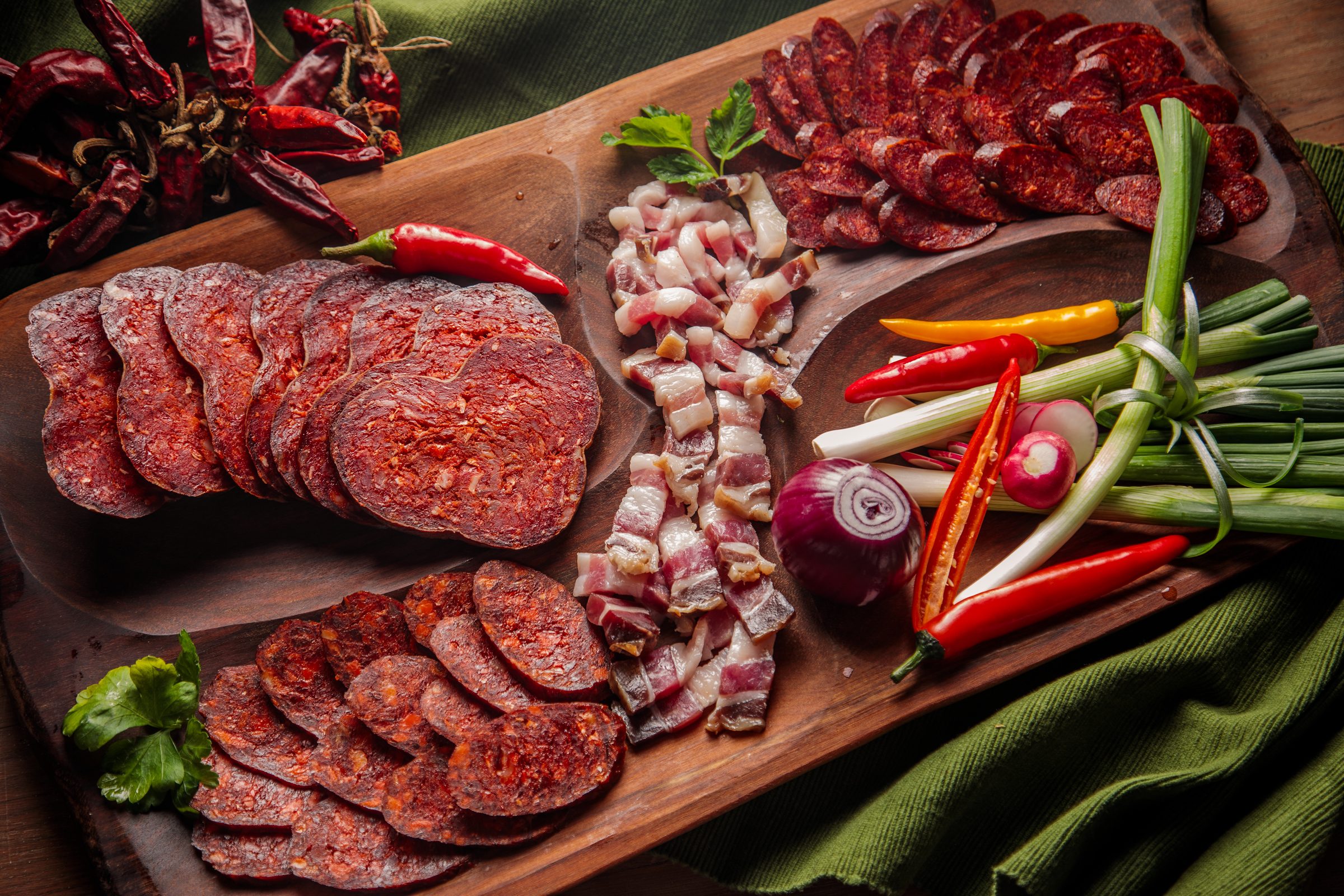 Baranja kulen, featured within a traditional Slavonian platter © Romulić & Stojčić
Baranja kulen, featured within a traditional Slavonian platter © Romulić & Stojčić Lika Potatoes
Lika Potatoes
For the latest travel info, bookmark our main travel info article, which is updated daily.
Read the Croatian Travel Update in your language - now available in 24 languages
First Large Investment since Austro-Hungarian Empire in Port Infrastructures
Among the contracts worth 50 million kuna, signed by Prime Minister Andrej Plenković this past week for 18 projects for port infrastructure in seven coastal counties, at the forefront with 12 million kuna is the Split-Dalmatia County Port Authority. This County generated 50 percent of all nautical overnights in Croatia, while this ambitious four-year programme valued at 180 million kuna has been silently coming near to completion
Klis Revives the Rich History of the Fortress with 1.2m Euro Project
A new project for Klis fortress has been granted funds by the Interreg IPA Cross Border Cooperation program.


